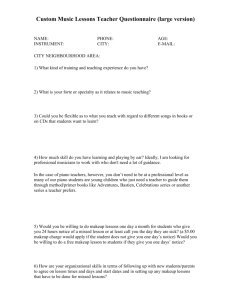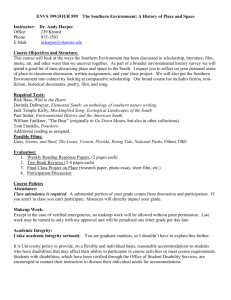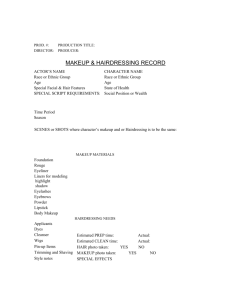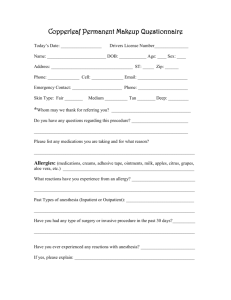Lesson Plan
advertisement
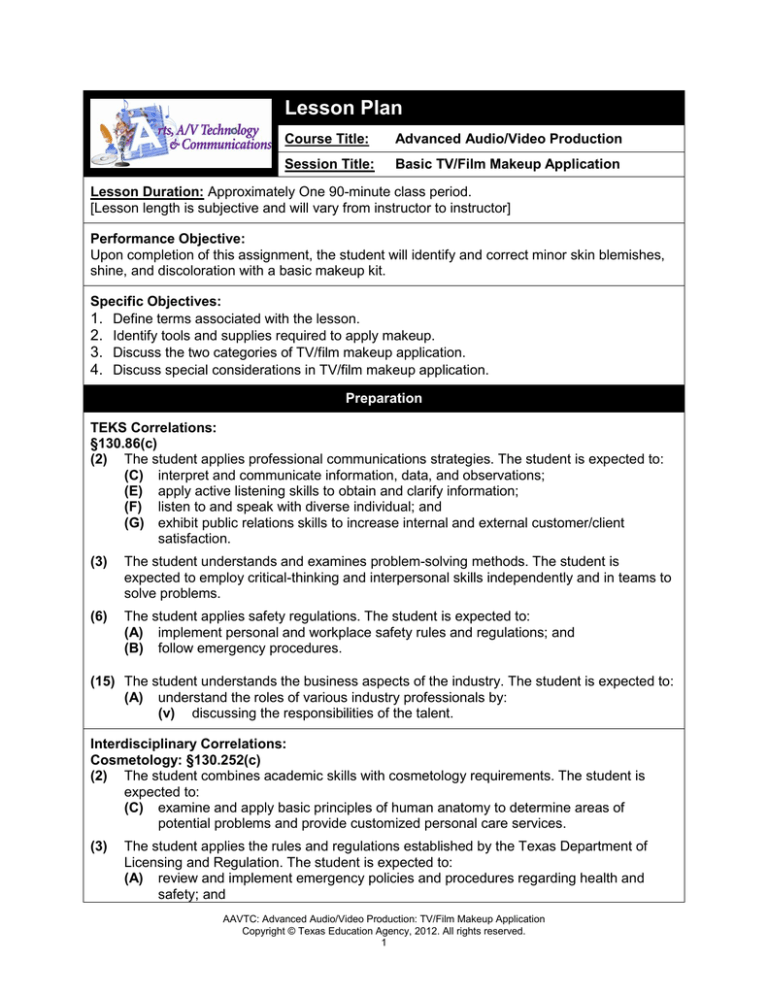
Lesson Plan Course Title: Advanced Audio/Video Production Session Title: Basic TV/Film Makeup Application Lesson Duration: Approximately One 90-minute class period. [Lesson length is subjective and will vary from instructor to instructor] Performance Objective: Upon completion of this assignment, the student will identify and correct minor skin blemishes, shine, and discoloration with a basic makeup kit. Specific Objectives: 1. Define terms associated with the lesson. 2. Identify tools and supplies required to apply makeup. 3. Discuss the two categories of TV/film makeup application. 4. Discuss special considerations in TV/film makeup application. Preparation TEKS Correlations: §130.86(c) (2) The student applies professional communications strategies. The student is expected to: (C) interpret and communicate information, data, and observations; (E) apply active listening skills to obtain and clarify information; (F) listen to and speak with diverse individual; and (G) exhibit public relations skills to increase internal and external customer/client satisfaction. (3) The student understands and examines problem-solving methods. The student is expected to employ critical-thinking and interpersonal skills independently and in teams to solve problems. (6) The student applies safety regulations. The student is expected to: (A) implement personal and workplace safety rules and regulations; and (B) follow emergency procedures. (15) The student understands the business aspects of the industry. The student is expected to: (A) understand the roles of various industry professionals by: (v) discussing the responsibilities of the talent. Interdisciplinary Correlations: Cosmetology: §130.252(c) (2) The student combines academic skills with cosmetology requirements. The student is expected to: (C) examine and apply basic principles of human anatomy to determine areas of potential problems and provide customized personal care services. (3) The student applies the rules and regulations established by the Texas Department of Licensing and Regulation. The student is expected to: (A) review and implement emergency policies and procedures regarding health and safety; and AAVTC: Advanced Audio/Video Production: TV/Film Makeup Application Copyright © Texas Education Agency, 2012. All rights reserved. 1 (B) research risks and potentially hazardous situations to maintain a clean record of safety when providing personal care services. Instructor/Trainer References: 1. Research online course for make-up applications 2. Research Maksymilian Faktorowicz, the Father of modern make-up Instructional Aids: 1. Basic TV/Film Makeup Application slide presentation 2. TV/Film Makeup Application Rubric 3. TV/Film Makeup Application Poster Handout 4. TV/Film Makeup Application Poster Checklist Materials Needed: 1. Light/medium/dark tone foundations 2. Mascara 3. Powder 4. Assorted blushes 5. Assorted lipsticks 6. Assorted eye shadows 7. Makeup sponges 8. Foam sponge 9. Assorted brushes 10. Cotton swabs 11. Tissues 12. Baby oil or glycerin 13. Makeup remover facial wipes 14. Carry case for makeup materials 15. Chair/stool 16. Magazines Equipment Needed: 1. Computer with internet connection and appropriate software for slide presentation 2. DVD player 3. Projector 4. Camera 5. Lights Learner Notebook Writing utensil AAVTC: Advanced Audio/Video Production: TV/Film Makeup Application Copyright © Texas Education Agency, 2012. All rights reserved. 2 Introduction MI Introduction (LSI Quadrant I): SAY: Most celebrities wouldn’t be caught dead without being completely ‘made up’, especially with the advent of HDTV. Now, bags, sags, and wrinkles are even more noticeable than ever. However, the main goal of most makeup artists for TV and film is to use a minimal amount of makeup products to keep a natural look for the talent. Many celebrities bring their own makeup artists along on a shoot because they are accustomed to the skin and hair attributes of their client. However, most people on TV do not have their own personal stylist. You may not have an inclination to become a makeup artist yourself, but it is a good idea for any production company to have a makeup kit and someone who knows something about applying makeup for the camera on staff. Today, we’re going to cover basic and corrective makeup applications used in television and film. Outline MI Outline (LSI Quadrant II): Instructor Notes: I. NOTE: Prior to the lesson, set up a small lit set with camera hooked up to projector, and a high chair or stool for your ‘model’ to sit in later in the lesson. While you will use a projector at first for the presentation, once you begin the makeup application make sure the students have handouts of the slide presentation to follow along. Define the terms associated with the lesson A. Makeup Artist - An artist who works in the medium of makeup and hair. B. Makeup - The decorations placed directly on the skin or hair of an actor for cosmetic or artistic effect. C. Foundation - A flesh-toned cosmetic applied to the face to create an even, uniform color to the complexion, and sometimes, to change the natural skin tone. Foundation applied to the body is generally referred to as body paint. D. Applicator - Powder puffs or sponges used to transfer makeup from container to talent E. Brush - Used to apply, blend, or contour powder product on the talent AAVTC: Advanced Audio/Video Production: TV/Film Makeup Application Copyright © Texas Education Agency, 2012. All rights reserved. 3 II. Identify and define tools and materials used in application of TV/film makeup. A. Light/medium/dark tone foundations B. Mascara C. Powder D. Assorted blushes E. Assorted lipsticks F. Assorted eye shadows G. Makeup sponges H. Assorted brushes I. Makeup sponges J. Cotton swabs K. Tissues L. Makeup remover facial wipes M. Carry case for makeup materials III. Discuss the two categories of TV and film makeup application. A. Basic - Can be as simple as brushing on some translucent powder to cover some shine to applying a full face of makeup. B. Corrective - Could involve such things as minimizing puffy bags under the eyes or a bump on the nose with contouring and shading to using a highlighter to lighten dark circles under the eyes. IV. Discuss special considerations in TV/film makeup application. A. Shine 1. Very pervasive on the set due to several factors one’s own natural skin oil and the heat produced by lighting instruments. 2. Although lighting technology has lowered the actual temperature of lighting instruments, several working lamps can cause talent to perspire. 3. Tension or stress felt by the talent can also induce an unwanted shine. You combat shine with POWDER. If you have translucent powder in the makeup case, dust some on your talent with a soft bristle brush or a powder puff. Don’t forget to dust off high foreheads and balding heads-they can shine too! B. Environment - It is best to apply and check makeup under the same color temperature lamps as you will be shooting under. C. Sanitation – 1. You should use disposable makeup applicators so that you do not cross- Show students each item as you discuss its use. AAVTC: Advanced Audio/Video Production: TV/Film Makeup Application Copyright © Texas Education Agency, 2012. All rights reserved. 4 contaminate from one person to another. 2. Makeup can be contaminated when dipping directly in the container after applying to talent. Instead, take out the amount you’ll need and apply from a plate or palette. Keep brushes clean by occasionally washing them with hair shampoo. Application MI Guided Practice (LSI Quadrant III): Demonstrate to the class how to apply basic makeup using a student as model or one as makeup artist and another as the model. Make sure that you are working under studio lighting and projecting the image for students to see. Ensure that students have handouts of slide presentation to follow. • • • • • • • Apply foundation using a moist foam rubber sponge, select a shade that matches skin tone as close as possible, unless trying to darken or lighten. Apply eye shadow: Powder or cake type holds up better under studio lights. Discuss how you can add depth and size to the eye by using a darker shade. Discuss how you can lighten and ‘open’ heavy-lidded eyes with a dot of ivory or yellow under the eye brow. Apply lipstick: Choose a color that will harmonize with skin coloration and wardrobe. Remind students that an applicator such as a lip brush should be used between talents to avoid cross-contamination. Blot lips with a tissue to avoid unnatural shine. Bring a darker skin tone student to the chair. Discuss how appropriate shades of makeup are available for darker skin tones, but generally can be used more sparingly. With very dark skin, the tonal reflectance level can drop so low that a loss of form and dimension result. A drop of baby oil or glycerin can preserve the highlights. Discuss with the students how corrective makeup can be used to cover flaws. Demonstrate on a volunteer. Apply the foundation and blend in shades of makeup that are either darker or lighter. Discuss with students about contouring; remind them that a darker shade of makeup than the foundation or base is used to downplay features, such as a high forehead or an overly prominent nose. Demonstrate to the students how contouring can also be used to add depth to flatter areas such as the cheeks. Discuss how, in highlighting, the object is to pull the viewers’ eye toward certain facial features or areas. A shade of makeup that is lighter than the foundation is used to achieve this. Discuss how shadowy areas under the eyes and lower lip that may appear darker on camera can be lightened with a highlighter. Discuss makeup removal with the students. Inform them that some people may prefer to leave it on, but others will want it removed. Demonstrate removal of makeup using a facial wipe. AAVTC: Advanced Audio/Video Production: TV/Film Makeup Application Copyright © Texas Education Agency, 2012. All rights reserved. 5 MI Independent Practice (LSI Quadrant III): Have students pair up with a partner or in small groups (depending on your available materials). Distribute brushes and makeup as available. Instruct students to practice on one another, focusing on decreasing shine and correcting problem areas. Students will follow the directions on the Makeup Application Poster Handout to create a poster with images that reflect terms, supplies, and makeup application concepts they have learned. Teacher will circulate through lab to redirect/reteach as necessary. Summary MI Review (LSI Quadrants I and IV): Q & A session Q: How would you correct for dark circles under the eyes? A: Use a highlighter or lighter foundation to lighten. Q: There is a shine on the talents’ high forehead. How do you correct for this? A: Try brushing on some translucent powder to dull down. Q: True or false? It is acceptable to apply foundation to the talent’s face with your fingers. A: False. Use a sponge. Q: What are causes of shine? A: Natural oils in the skin or head produced by lighting instruments, tension, or stress of talent Q: What are some the items you might find in a cosmetics case? A: Foundation, blush, powder, lip color, eye shadow, mascara, brushes, sponges, Q-tips tissues, and/or makeup remover facial wipes. Q: True or false? Makeup area should always be evenly lit with large fluorescent lighting instruments. A: False. Try to apply/check makeup under the same lighting you are shooting in. Q: How can you correct for a large bump on the nose? A: By contouring it with a darker shade of foundation. AAVTC: Advanced Audio/Video Production: TV/Film Makeup Application Copyright © Texas Education Agency, 2012. All rights reserved. 6 Evaluation MI Informal Assessment (LSI Quadrant III): Teacher will observe during guided practice to assess student understanding of concepts and techniques. Revise/reteach will occur as needed before moving to Independent Practice portion of the lesson. MI Formal Assessment (LSI Quadrant III, IV): Use the TV/Film Makeup Application Rubric to evaluate student application of makeup during the Independent Practice portion of the lesson. Assess students’ posters using the Makeup Application Poster Checklist. Extension MI Extension/Enrichment (LSI Quadrant IV): Students may research Maksymilian Faktorowicz on the internet and create a poster with information about him. He is considered to be the ‘father’ of modern makeup. Students will apply makeup techniques in future projects. AAVTC: Advanced Audio/Video Production: TV/Film Makeup Application Copyright © Texas Education Agency, 2012. All rights reserved. 7 TV/Film Makeup Application Rubric Points 33 29 26 Use tools correctly Used tools correctly and put up clean. Used tools correctly, put away dirty. Used tools correctly. Did not put away tools. Careless Did not with touch tools. Left tools. them out. Overall quality of work Very realistic. Somewhat realistic. Realistic but needs blending. Not very realistic. Did not participate. The team Some people did most of the work while other(s) watched. One person did most of the work while other(s) watched. The team did not work well together. No one worked. Teamwork worked very well together. 23 20 TOTAL AAVTC: Advanced Audio/Video Production: TV/Film Makeup Application Copyright © Texas Education Agency, 2012. All rights reserved. 8 Totals TV/Film Makeup Application Poster Create a poster using images cut out from magazines that illustrate the terminology, materials/supplies, and makeup application concepts we have been studying. You will be graded on the use of the following criteria: Project title/labels 5 pts (Materials/supplies used in the industry) Foundation 5 pts Blush 5 pts Powder 5 pts Lip Color 5 pts Eye Shadow 5 pts Mascara 5 pts Brushes 5 pts (Makeup application concepts) Contouring Highlighting Shine Color 10 pts 10 pts 10 pts 10 pts Overall quality of work 20 pts (Looking for creativity and neatness) A total of 100 points is possible on this assignment. AAVTC: Advanced Audio/Video Production: TV/Film Makeup Application Copyright © Texas Education Agency, 2012. All rights reserved. 9 Makeup Application Poster Checklist Use of Terminology Project title/labels Total possible score 5 Use of materials/supplies Foundation 5 Blush 5 Powder 5 Lip color 5 Eye shadow 5 Mascara 5 Brushes Use of makeup application concepts? Contouring 5 10 Highlighting 10 Shine 10 Color 10 Overall quality of work? Neat/creative? 20 Total score 100 AAVTC: Advanced Audio/Video Production: TV/Film Makeup Application Copyright © Texas Education Agency, 2012. All rights reserved. 10 Actual Score
